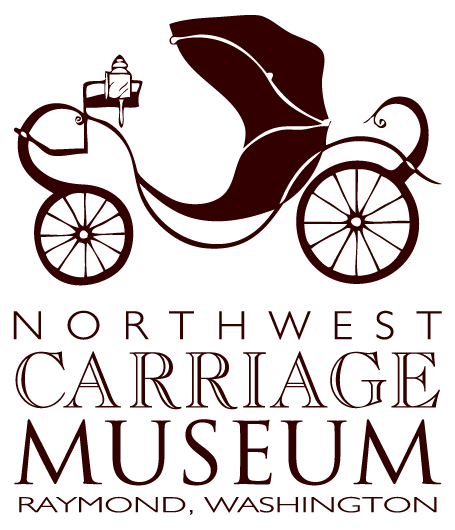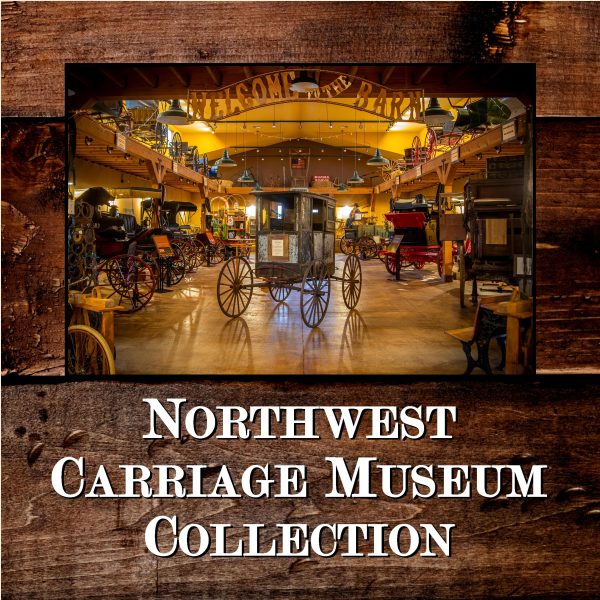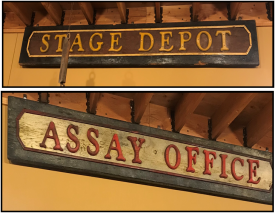 The Butterfield Overland Stagecoach Service operated from 1858 to 1861–it carried passengers and US mail from St Louis, Missouri to San Francisco, California. The route covered almost 2,800 miles through mostly the Southern states. The contract with the US Postal Service was 29 days to get mail across the country. It is estimated there were 175 stage stops along the route; one of those stops was Temecula, California which is now famous for their grape vineyards and wineries. These two signs, which once hung on buildings in Temecula during the Butterfield run, now hang proudly in the Museum’s Barn addition. They are remarkable pieces of American history.
The Butterfield Overland Stagecoach Service operated from 1858 to 1861–it carried passengers and US mail from St Louis, Missouri to San Francisco, California. The route covered almost 2,800 miles through mostly the Southern states. The contract with the US Postal Service was 29 days to get mail across the country. It is estimated there were 175 stage stops along the route; one of those stops was Temecula, California which is now famous for their grape vineyards and wineries. These two signs, which once hung on buildings in Temecula during the Butterfield run, now hang proudly in the Museum’s Barn addition. They are remarkable pieces of American history.
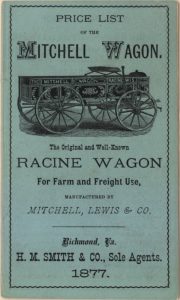
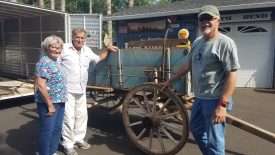 This beautiful Mitchell Farm Wagon was conserved several years ago and is currently on display in the museum. Michell Lewis was one of America’s finest wagon makers and was known for building strong and durable wagons out of Racine, Wisconsin during the second half of the 19th century. In 1882, William Mitchell, grandson of founder Henry Mitchell, opened a West coast facility in Portland, Oregon. Wagons being built in Racine were shipped via railroad to Portland, where they were sold. In 1892, Mitchell Lewis merged with Staver and Walker, producer of plows and related farm equipment. The new company was named “Mitchell Lewis and Staver.” Our wagon was originally bought by a farm family near Battle Ground, Washington in 1892. That family had it for many years and eventually sold it to another farm family who had it 61 years. Members from that family, while on a car club tour at our museum, offered to donate the wagon to us. We are the third owners of this historic vehicle. It was in the shop for several months, undergoing a complete conservation. We were able to save almost the complete vehicle–including original paint, pin stripping, and patina. The wagon is totally functional and very historical. Mitchell Lewis went on to make cars and trucks in the early 20th century. Mitchell Lewis Staver is still in business and based in Portland: they make and sell agricultural irrigation systems around the world.
This beautiful Mitchell Farm Wagon was conserved several years ago and is currently on display in the museum. Michell Lewis was one of America’s finest wagon makers and was known for building strong and durable wagons out of Racine, Wisconsin during the second half of the 19th century. In 1882, William Mitchell, grandson of founder Henry Mitchell, opened a West coast facility in Portland, Oregon. Wagons being built in Racine were shipped via railroad to Portland, where they were sold. In 1892, Mitchell Lewis merged with Staver and Walker, producer of plows and related farm equipment. The new company was named “Mitchell Lewis and Staver.” Our wagon was originally bought by a farm family near Battle Ground, Washington in 1892. That family had it for many years and eventually sold it to another farm family who had it 61 years. Members from that family, while on a car club tour at our museum, offered to donate the wagon to us. We are the third owners of this historic vehicle. It was in the shop for several months, undergoing a complete conservation. We were able to save almost the complete vehicle–including original paint, pin stripping, and patina. The wagon is totally functional and very historical. Mitchell Lewis went on to make cars and trucks in the early 20th century. Mitchell Lewis Staver is still in business and based in Portland: they make and sell agricultural irrigation systems around the world.
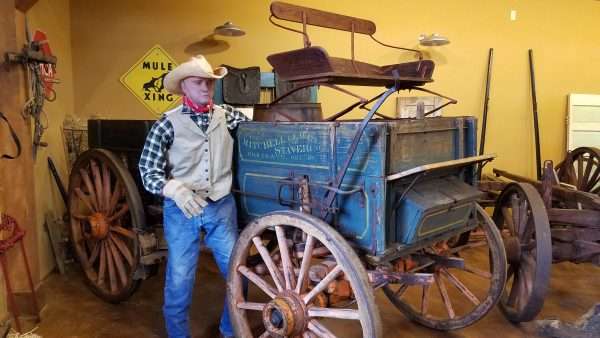
 Aside from our incredible collection of horse-drawn vehicles, we have so many other fascinating artifacts to look at in the museum. Here is a “pole” or “spoon” shovel hanging in our Wheelwright/Blacksmith shop. These shovels were commonly used in the early 20th century (1910 to 1940) for digging telephone/power poles. They were replaced with electric augers or power digging machines. Some handles were over 10 feet long. These long spoon shovels were used by 10 to 12 man crews along with spades (pointed shovels) and steel bars to dig deep power pole holes.
Aside from our incredible collection of horse-drawn vehicles, we have so many other fascinating artifacts to look at in the museum. Here is a “pole” or “spoon” shovel hanging in our Wheelwright/Blacksmith shop. These shovels were commonly used in the early 20th century (1910 to 1940) for digging telephone/power poles. They were replaced with electric augers or power digging machines. Some handles were over 10 feet long. These long spoon shovels were used by 10 to 12 man crews along with spades (pointed shovels) and steel bars to dig deep power pole holes.
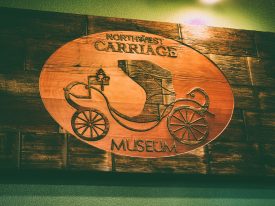 Does anyone remember the old redwood water tower out on the South Fork of the Willapa River? We don’t have the tower itself, but we do have two beautiful Northwest Carriage Museum signs made from the original water tower redwood hanging above our front doors. These incredible pieces of artwork were designed and created by our good friend and wood carver, Jeffro Uitto, out in Tokeland. Jeffro is a woodworking extraordinaire and a man of many talents, you should see the magic he works with driftwood! His work is known throughout the world. Come take a look!
Does anyone remember the old redwood water tower out on the South Fork of the Willapa River? We don’t have the tower itself, but we do have two beautiful Northwest Carriage Museum signs made from the original water tower redwood hanging above our front doors. These incredible pieces of artwork were designed and created by our good friend and wood carver, Jeffro Uitto, out in Tokeland. Jeffro is a woodworking extraordinaire and a man of many talents, you should see the magic he works with driftwood! His work is known throughout the world. Come take a look!
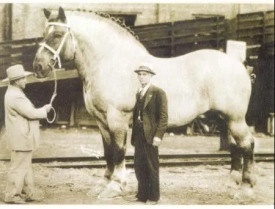
This picture is said to show Mammoth, the Guinness Record holder for largest horse. While the photo is not confirmed and may be too new to be the authentic record-holder, it certainly depicts an outrageously large horse as a reference point for Mammoth’s impressive size!
Did you know the world’s biggest horse lived in the 19th century? Originally named Samson, Mammoth was a Shire horse gelding born in 1846 at Bedfordshire, England. Towering at 21 hands and 2 ½ inches (about 86 1/4inches), the horse was aptly renamed Mammoth, and he weighed a hefty 3,360lbs! By comparison, many cars don’t even weigh that much: For instance, a 2022 Honda Civic weighs between 2,877 and 3,077 pounds, depending on the model.
Fun fact… the average 1000 lb horse drops about 31 lbs of manure and 2.4 gallons of urine per day. I would not have wanted to be in charge of mucking Mammoth’s stall!
 The Butterfield Overland Stagecoach Service operated from 1858 to 1861–it carried passengers and US mail from St Louis, Missouri to San Francisco, California. The route covered almost 2,800 miles through mostly the Southern states. The contract with the US Postal Service was 29 days to get mail across the country. It is estimated there were 175 stage stops along the route; one of those stops was Temecula, California which is now famous for their grape vineyards and wineries. These two signs, which once hung on buildings in Temecula during the Butterfield run, now hang proudly in the Museum’s Barn addition. They are remarkable pieces of American history.
The Butterfield Overland Stagecoach Service operated from 1858 to 1861–it carried passengers and US mail from St Louis, Missouri to San Francisco, California. The route covered almost 2,800 miles through mostly the Southern states. The contract with the US Postal Service was 29 days to get mail across the country. It is estimated there were 175 stage stops along the route; one of those stops was Temecula, California which is now famous for their grape vineyards and wineries. These two signs, which once hung on buildings in Temecula during the Butterfield run, now hang proudly in the Museum’s Barn addition. They are remarkable pieces of American history.






